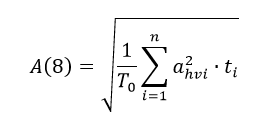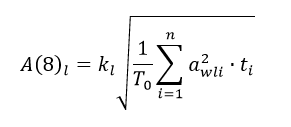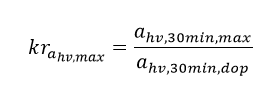Misją Instytutu jest dzialalność naukowo-badawcza prowadząca do nowych rozwiązań technicznych i organizacyjnych użytecznych w kształtowaniu warunków pracy zgodnych z zasadami bezpieczeństwa pracy i ergonomii oraz ustalanie podstaw naukowych do właściwego ukierunkowywania polityki społeczno-ekonomicznej państwa w tym zakresie.

BASIC TERMS RELATED TO MECHANICAL VIBRATIONS IN THE WOR ENVIRONMENT
Root-mean-square frequency-weighted accelerations
The basic quantity used to evaluate the exposure to hand-arm and whole-body vibrations is the frequency-weighted root-mean-square (r.m.s) acceleration, measured in the x, y and z directions at the workstation for each i identifiable operation. The values of the measured acceleration are weighed (corrected) using the appropriate correction methods applicable for each type of vibration.
For vibrations transmitted through the hand and arms, the following quantities of frequency-weighted r.m.s acceleration are used:

where: x, y, z are the component direction of vibrations, i is the number of operations
For whole-body vibrations, the following quantities of frequency-weighted r.m.s acceleration are used:

where: x, y, z are the component direction of vibrations, i is the number of operations
The most important quantity in the assessment of hand-arm and whole-body vibrations is the total duration during one work shift denoted by t and represented in minutes. It is the sum of the durations ti of the individual operations, calculated according to:

Where: n - is the number of operations performed in the vibration exposure at a workplace.
Quantities used to evaluate exposure to hand-arm vibrations
The basic quantities used to evaluate the hand-arm exposure vibrations are the vector sum of the three weighted acceleration values and daily vibration exposure.
For each separate operation performed in the hand-arm exposure vibrations, the vector sum of the frequency-weighted r.m.s vibration acceleration(vibration total value) ahvi is calculated according to the following relationship:
Where: ahwxi, ahwyi, ahwzi, are r.m.s values of the acceleration measured in the directions x, y and z in the performance of the i-th operation.
To evaluate the short-term exposure to vibration (for the operations of the total duration of 30 minutes and less) vector sum of frequency-weighted r.m.s acceleration sum is used. For the risk assessment a maximum value (ahv,30min,max) of a vector sum from the vector sums determined for each activity in the duration time less than or equal to 30 minutes shall be chosen, according to the equation:

To assess the exposure of hand-arm vibrations when the total time of exposure t exceeds 30 minutes, the value used is called 8-hour (or otherwise daily) vibration exposure calculated by the relationship:

where:
n - number of operations
i - the number of the next operation performed in the vibration exposure
ahvi - vector sum of frequency-weighted r.m.s acceleration for the the i-th operation
ti - the total duration (per day) of vibration exposure for the i-th operation
T0 - the reference duration of 8 hours or an equivalent of 28800 s
The quantities used to assess exposure to whole-body vibrations
The basic quantities used to assess the exposure to hand-arm vibration are: the maximum value of frequency-weighted acceleration, and 8-hour (daily) vibration exposure measured in the dominant vibration direction.
The dominant value of frequency-weighted acceleration (aw,30min,max) is used to assess short-term exposure to vibrations (for operations with duration of 30 minutes or less). It is determined in accordance with the dependence:

where:
n - number of operations,
i - the number of operations performed in the vibration exposure,
l - direction of vibration (x, y lub z),
awli – the root-mean-square frequency-weighted value of the acceleration, measured in the x, y and z direction, determined over the time period ti.
When the worker's total exposure time for vibration exceeds 30 minutes to assess whole-body vibration is calculated daily vibration exposure for each vibration direction according to the equation:

where:
n - number of operations,,
i - the number of operations performed in the vibration exposure,
l - direction of vibration (x, y or z),
kx = ky = 1,4 for x and y directions; kz = 1 for the z direction,
ti - time of performing the i-th operation,
awli - the frequency-weighted value of vibration acceleration, measured in the x, y and z direction for the i-th action in vibration exposure.
The assessment of exposure to whole-body vibration is based on the highest value of the 8-hour exposure selected from the exposures calculated in the three directions: max{Ax(8), Ay(8), Az(8)}.
ACTION VALUES
When the value of the character of vibration exceeds the "action value", the employer is obliged to take the actions specified in the law to reduce the occupational risk associated with vibrations. The action values for the quantities characterizing mechanical vibrations in the work environment are given in an annex to the ordinance of the Minister of Economy and Labor of August 5, 2005 on health and safety at work associated with exposure to noise or mechanical vibrations (Journal of Laws of 2005, No. 157, item 1318). The action values are given in Table 1.
Table 1. Action values for quantities characterizing mechanical vibrations.
| Type of vibration | The quantities characterizing mechanical vibration in the working environment | Action value |
| Hand-arm vibration |
Daily exposure A(8) 8-h energy-equivalent vibration total value of frequency-weighted r.m.s acceleration for the three measured axes of vibration (ahwx, ahwy, ahwz) |
2,5 m/s2 |
| Whole-body vibration |
Daily exposure A(8) 8h energy-equivalent vibration total value of frequency-weighted vibration r.m.s acceleration, maximum of the values in the three directional axes, taking into account the proper coefficients (1,4awx, 1,4awy, awz) |
0,5 m/s2 |
LIMIT VALUE
The quantities characterizing mechanical vibrations in the work environment and the limit values for these quantities are specified in the Regulation of the Minister of Family, Labor and Social Policy of June 12, 2018 regarding the highest admissible concentrations and intensities of factors harmful to health in the work environment (Journal of Laws of 2018, item 1286). According to this regulation, vibrations transmitting to the human body by hand-system (hand-arm vibration) are characterized by:
− The daily vibration exposure (A(8)), expressed for 8-h energy-equivalent vibration total value of frequency-weighted r.m.s acceleration, determined for the three measured axes of vibration (ahwx, ahwy, ahwz).
− Exposure lasting for a maximum duration of 30 minutes is expressed as the vibration total value of frequency-weighted r.m.s acceleration (ahv, 30min) determined for the three directional components (ahwx, ahwy, ahwz).
Whereas whole-body vibrations transmitted to the body as a whole, are characterized by:
− The daily vibration exposure (A(8)) is the maximum of the exposure values calculated for three directions: max{Ax(8), Ay(8), Az(8)}, expressed in 8h energy-equivalent vibration total value of frequency-weighted vibration r.m.s acceleration.
− Exposure lasting for a maximum duration of 30 minutes is expressed in the frequency-weighted vibration r.m.s acceleration (aw,30min), maximum of the values in the three directional axes, taking into account the proper coefficients (1,4awx, 1,4awy, awz)
Permissible values of mechanical vibrations may not exceed the values given in Table 2.
Table 2. Limit values of mechanical vibrations.
|
Types of human vibrations |
The quantities characterizing mechanical vibrations in the work environment |
Limit value |
|
Hand-arm vibration |
Daily vibration exposure, A(8) |
2.8 m/s2 |
|
Short-term exposure to hand-arm vibration, ahv, 30min |
11.2 m/s2 |
|
|
Whole-body vibration |
Daily vibration exposure, A(8) |
0.8 m/s2 |
|
Short-term exposure of whole-body vibration, aw, 30min |
3.2 m/s2 |
The above limit values of vibrations are used if other detailed provisions do not specify lower values. In the detailed regulations, limit values for mechanical vibrations related to young workers and pregnant women have been specified.
In the Regulation of the Council of Ministers of 5 July 2005 amending the regulation on the list of prohibited work for adolescents and the conditions of their employment for some of these works (Journal of Laws 2005, no. 136, item. 1145, last change Journal of Laws 2015 item 929) the admissible vibration values for young workers are given. According to this regulation, it is forbidden to employ young workers at work stations whose vibration values exceed the limit values given in
Table 3. Limit values of mechanical vibrations for young workers.
|
Types of human vibrations |
The quantities characterizing mechanical vibrations in the work environment |
Limit value |
|
Hand-arm vibration |
Daily vibration exposure, A(8) |
1.0 m/s2 |
|
Short-term exposure to hand-arm vibration, ahv, 30min |
4.0 m/s2 |
|
|
Whole-body vibration |
Daily vibration exposure, A(8) |
0.19 m/s2 |
|
Short-term exposure of whole-body vibration, aw, 30min |
0.76 m/s2 |
In the Regulation of the Council of Ministers of April 3, 2017 on the list of works that are onerous, dangerous or harmful to the health of pregnant women and women who breast-feed their baby (Journal of Laws 2017 item. 796) allowable values of vibrations for pregnant women were given. According to this Regulation, it is forbidden to employ pregnant women in conditions of exposure to whole body vibrations and in conditions of exposure to vibrations acting through upper limbs, the values of which exceed the admissible values given in Table 4.
Table 4. Limit values of mechanical vibrations for pregnant women.
|
Types of human vibrations |
The quantities characterizing mechanical vibrations in the work environment |
Limit value |
|
Hand-arm vibration |
Daily vibration exposure, A(8) |
1.0 m/s2 |
|
Short-term exposure to hand-arm vibration, ahv, 30min |
4.0 m/s2 |
|
|
Whole-body vibration |
Daily vibration exposure, A(8) |
Work forbidden |
|
Short-term exposure of whole-body vibration, aw, 30min |
RISK ASSESSMENT
The assessment of occupational risk related to exposure to mechanical vibrations is primarily based on the reference values determined for the daily and / or short-term exposure to mechanical vibrations (whole-body and hand-arm) in the work environment up to their permissible values. It should be considered whether the employee for whom the assessment is made belongs to a particular risk group (young person or pregnant woman). When assessing occupational risk, the principle described in PN-N-18002 "Occupational health and safety management systems" can be adopted. In line with this principle, it was assumed that the low and medium risk is an acceptable risk, a large risk - it is unacceptable. The risk is most often determined on the basis of the multiplication factor of exceeding the permissible exposure limit for vibration (k) of the measured value in relation to the limit value set for it:
|
k ≤ 0,5 |
low risk |
|
0,5 < k ≤ 1 |
medium risk |
|
k > 1,0 |
high risk |
When assessing the occupational risk associated with hand-arm vibration, a comparison of the 8-hour vibration exposure value is made, A (8) with the limit value A(8)dop and/or the maximum vector sum value of frequency-weighted r.m.s accelerations ahv,30min,max with limit value ahv,30min,dop. The corresponding multiples of the limit values will be described by the following formulas:
|
|
(1) |
|
|
(2)
|
In cases where the total duration of worker exposure to vibrations per day, t, is longer than 30 minutes (t > 30 min) and duration t and all n operations performed by the worker in vibration exposure is longer than 30 minutes (ti> 30 min), occupational risk assessment is based on an 8-hour exposure to vibration A(8) (multiplication factor calculated from formula (1)).
In cases where the total duration of exposure of the worker to vibration during the day, t, is longer than 30 minutes (t> 30 min), but although one of the operations performed during the working day in exposure to vibrations lasts 30 minutes or less (ti <= 30 min), occupational risk assessment is carried out both on the basis of 8-hour exposure to A(8) (multiplication factor calculated from formula (1)) and maximum vector sum of frequency-weighted r.m.s acceleration ahv,30min,max(multiplication factor calculated from formula (2)). The basis for the assessment is the greater of the designated multiplication factor.
In cases where the total duration for vibrations per day, t, is equal to or shorter than 30 min (30 min), the occupational risk assessment is carried out based on the maximum vector sum of the frequency-weighted r.m.s acceleration a ahv,30min,max (multiplication factor calculated from formula (2)).
When assessing the occupational risk related to whole-body vibration, a comparison of the value of the 8-hour exposure to Al(8) vibrations is made (the largest of the exposures designated for three directions: max{Ax(8), Ay(8), Az(8)} with the limit value A(8)dop and/or the dominant value aw,30min,max chosen from among the effective weighted vibration accelerations with admissible value aw,30min,dop. The appropriate multiples of the limit values will be described by the following formulas:
|
|
(3) |
|
|
(4) |
In cases where the total duration of worker exposure to vibrations per day, t, is longer than 30 min (t> 30 min) and duration t and all n operations performed by the worker in vibration exposure is longer than 30 minutes (ti> 30 min), occupational risk assessment is based on an 8-hour exposure to Al(8) vibrations (multiplication factor calculated from formula (3)).
In cases where the total duration of exposure of the worker to vibration during the day, t, is longer than 30 minutes (t> 30 min), but although one of the operations performed during the working day in exposure to vibrations lasts 30 minutes or less (ti <= 30 min), occupational risk assessment is performed based on 8-hour exposure to Al(8) (multiplication factor calculated from formula (3)) and dominant value aw,30min,max selected from frequency-weighted r.m.s accelerations (multiplication factor calculated from formula (4)). The basis for the assessment is the greater of the calculated multiplication factor.
In cases where the total duration of worker exposure to vibrations during a day, t, is equal to or less than 30 minutes (ti <= 30min), the occupational risk assessment is based on the dominant value selected from the frequency-weighted r.m.s vibration accelerations aw,30min,max (multiplication factor calculated from formula (4)).
When assessing the occupational risk related to exposure to mechanical vibrations, it should be noted that the values determined should be referred to the limit values appropriate for a given employee.
Regulation of the Council of Ministers of April 3, 2017 on the list of works that are onerous, dangerous or harmful to the health of pregnant women and women who breast-feed their baby








